George Harrison, the “quiet Beatle,” was anything but quiet when it came to his guitar playing. His distinctive style and tone were integral to the sound of The Beatles, and his choice of guitars played a crucial role in shaping that iconic sound. From humble beginnings with a basic acoustic to owning some of the most coveted instruments in rock history, Harrison’s guitar journey is a fascinating exploration of musical evolution and personal expression. This article delves into the impressive collection of George Harrison Guitars, detailing the instruments that became synonymous with his legendary career.
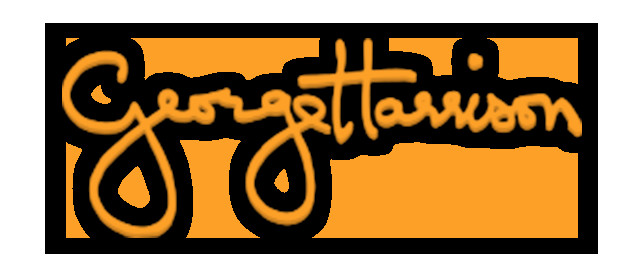 George Harrison logo
George Harrison logo
George Harrison’s musical impact is undeniable. While often referred to as the “quiet Beatle,” his contributions to songwriting and musicianship were anything but understated. His guitar work, characterized by tasteful melodies and signature riffs, provided the perfect complement to the songwriting prowess of Lennon and McCartney. Harrison’s guitar choices were as diverse as his musical tastes, ranging from budget-friendly acoustics to top-of-the-line electric models. His journey began, like many aspiring musicians, with an entry-level instrument.
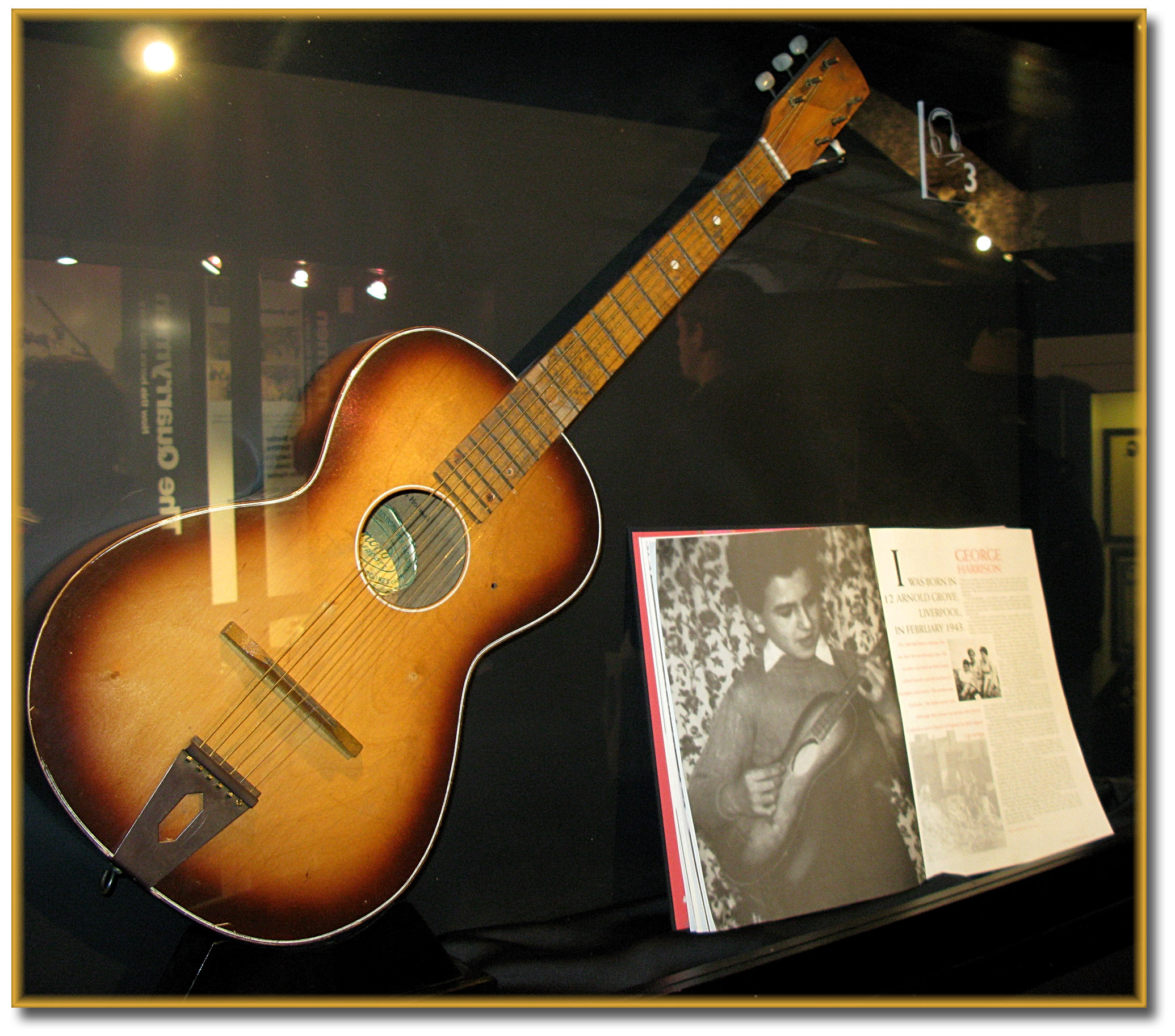 George Harrison at The Beatles Story museum in Liverpool
George Harrison at The Beatles Story museum in Liverpool
Early Days: Humble Beginnings and First Guitars
Rosetti 276 (Egmond 105/G) – 1956: The First Step
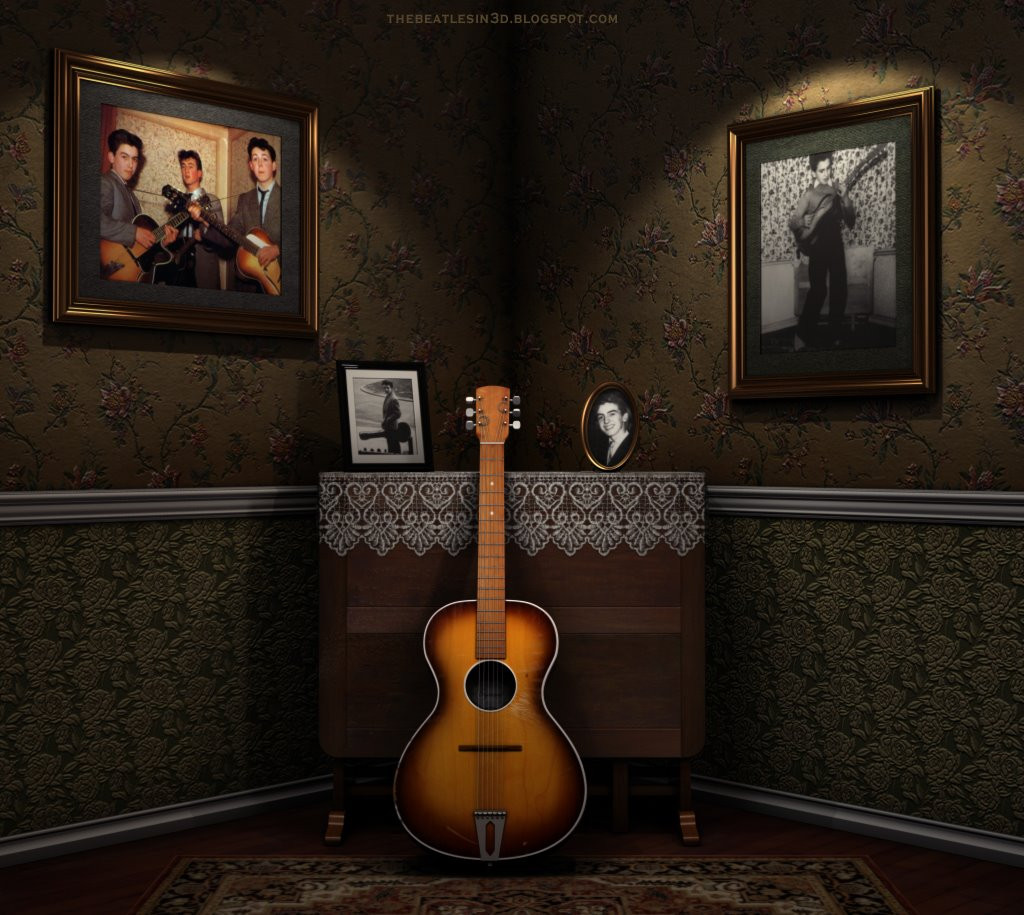 George Harrison's first guitar, a Rosetti 276 (Egmond 105/G) from 1956
George Harrison's first guitar, a Rosetti 276 (Egmond 105/G) from 1956
In 1956, George Harrison’s musical journey commenced with an acoustic guitar – a Rosetti 276, also known as an Egmond 105/G or Egmond Toledo. Egmond guitars, rebranded as Rosetti in the UK, were affordable instruments, perfect for beginners. Harrison himself described it as “a real cheapo, horrible little guitar but it was OK at the time.” His father purchased it second-hand for a mere $5.95 from a schoolmate.
Despite its humble nature, this Rosetti guitar was the catalyst for Harrison’s musical development. It was on this guitar that he learned chords and began to hone his skills, laying the foundation for his future as a world-renowned guitarist. Recently, a similar beginner’s guitar, believed to be Harrison’s first, surfaced after decades in storage, highlighting the historical significance even of his earliest instruments. This Rosetti, or Egmond, represents the very start of George Harrison’s incredible guitar story.
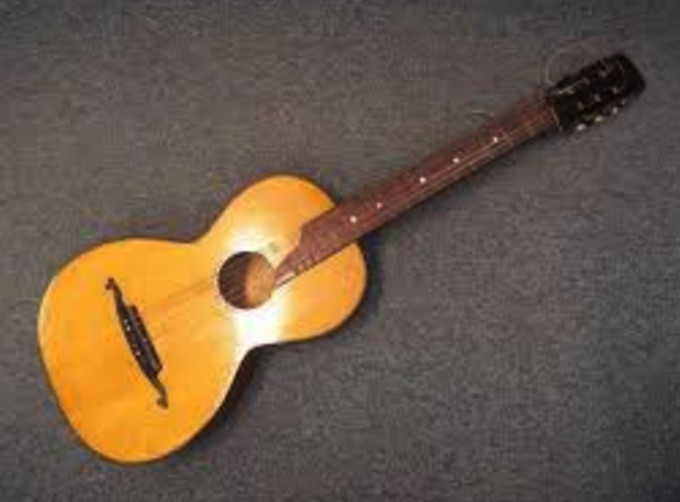 News clipping about George Harrison's first guitar being discovered and auctioned
News clipping about George Harrison's first guitar being discovered and auctioned
The journey from a “cheapo” guitar to international stardom is a testament to Harrison’s dedication and passion. His mother, Louise, played a pivotal role, encouraging his musical aspirations and supporting his early instrument purchases. She recognized his burgeoning talent and fostered his practice, even when George faced initial frustrations in learning the guitar. This unwavering support proved crucial as Harrison progressed rapidly, soon seeking an upgrade to a better instrument.
1958 Hofner President: An Upgrade in Sound and Style
 George Harrison with his 1958 Hofner President guitar
George Harrison with his 1958 Hofner President guitar
As George Harrison’s skills progressed, he yearned for a better guitar. Around 1958, he acquired a Hofner President, a significant step up from his beginner Rosetti. This archtop acoustic guitar, common in jazz and popular music at the time, offered improved playability and a richer tone. The Hofner President marked Harrison’s move towards more professional instruments, reflecting his growing musical ambitions.
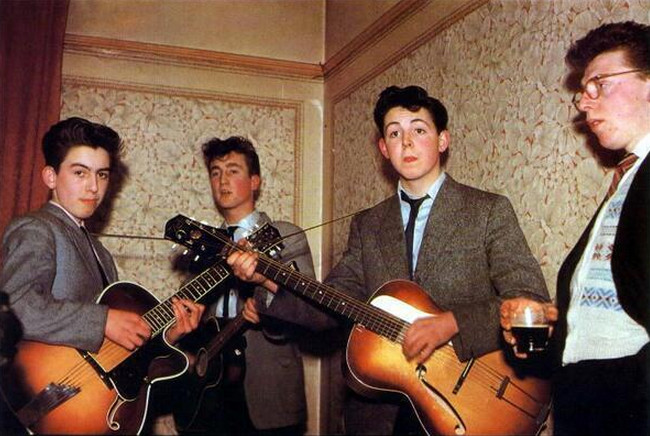 George Harrison with The Quarry Men holding his Hofner President guitar
George Harrison with The Quarry Men holding his Hofner President guitar
It’s believed George swapped this Hofner President later for a Hofner Club 40, marking his entry into the world of electric guitars. This transition was essential as The Quarrymen, the precursor to The Beatles, shifted from skiffle to rock and roll, necessitating electric instruments to achieve the desired sound.
Hofner Club 40 (1959): George’s First Electric Guitar
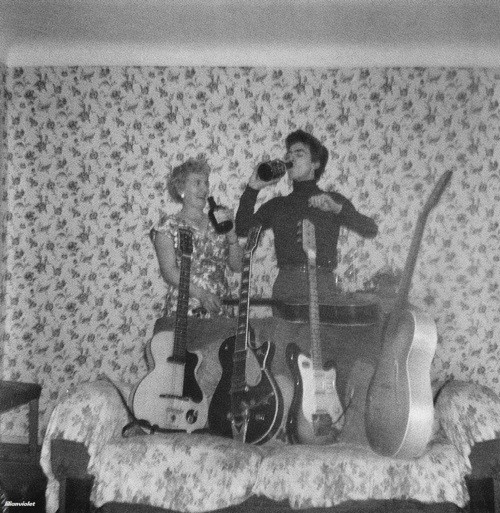 Hofner Club 40 guitar, similar to George Harrison's first electric guitar
Hofner Club 40 guitar, similar to George Harrison's first electric guitar
In 1959, George Harrison took a monumental step in his guitar journey by acquiring his first electric guitar – a Hofner Club 40. This model, also favored by John Lennon, was a popular choice for aspiring rock and roll musicians in the late 1950s. The Hofner Club 40 was a relatively affordable electric guitar, enabling young musicians like Harrison to access the amplified sounds that were revolutionizing popular music.
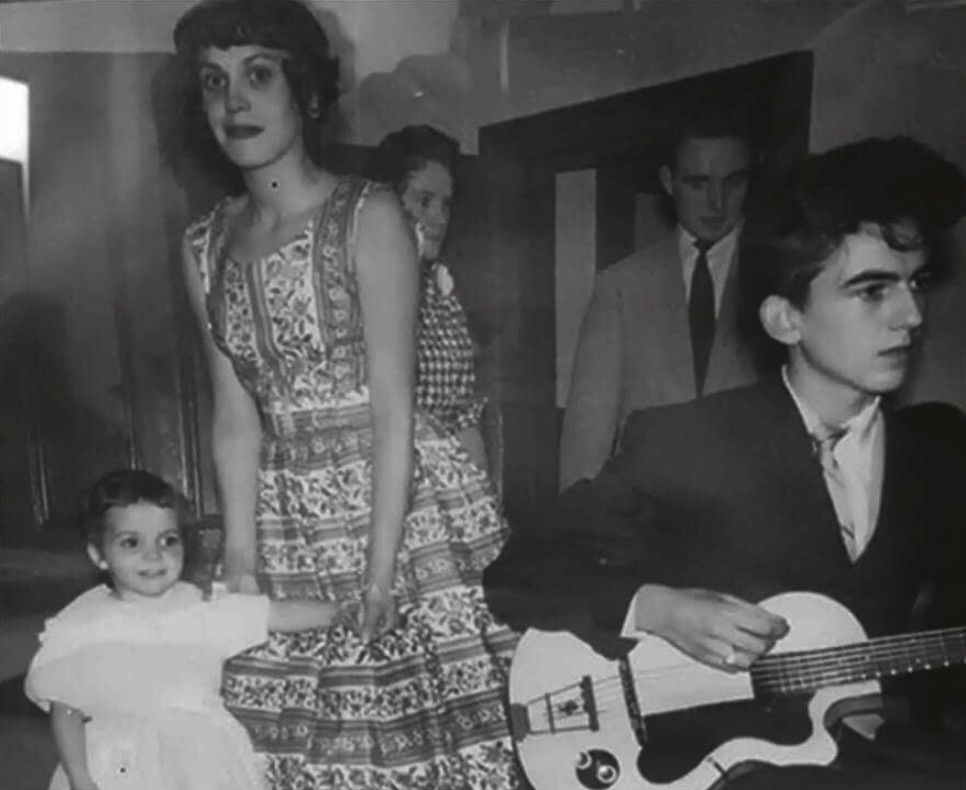 Vintage advertisement for Hofner Club 40 guitars
Vintage advertisement for Hofner Club 40 guitars
Harrison’s transition to the Hofner Club 40 coincided with The Quarrymen’s evolution into a rock and roll band. The electric guitar allowed them to perform louder and explore the dynamic sounds of the burgeoning rock scene. Interestingly, Harrison acquired his Club 40 in a swap with Ray Ennis of The Swinging Blue Jeans, trading his Hofner President acoustic for it. This anecdote illustrates the early music scene’s collaborative and swapping culture among musicians.
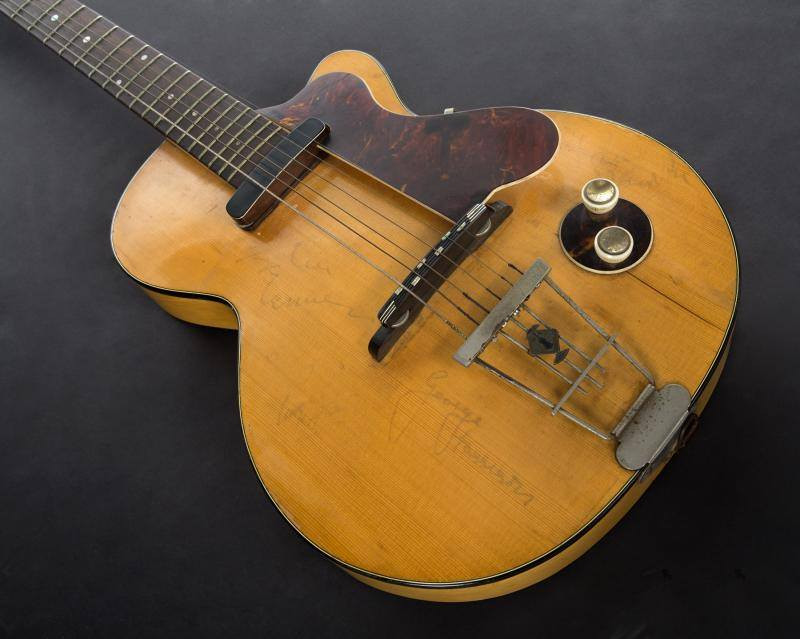 George Harrison's Hofner Club 40 guitar on display at auction
George Harrison's Hofner Club 40 guitar on display at auction
Harrison’s Hofner Club 40 later became a prize in a German “Beat Band Battle” competition in 1966, highlighting its significance as his first electric guitar and its connection to the early Beatles era. This instrument marked a pivotal point in Harrison’s career, propelling him into the electric guitar world and setting the stage for his future iconic guitar choices.
Stepping Up: American Guitars and Iconic Sounds
1958 Resonet Futurama Grazioso: A Unique Find
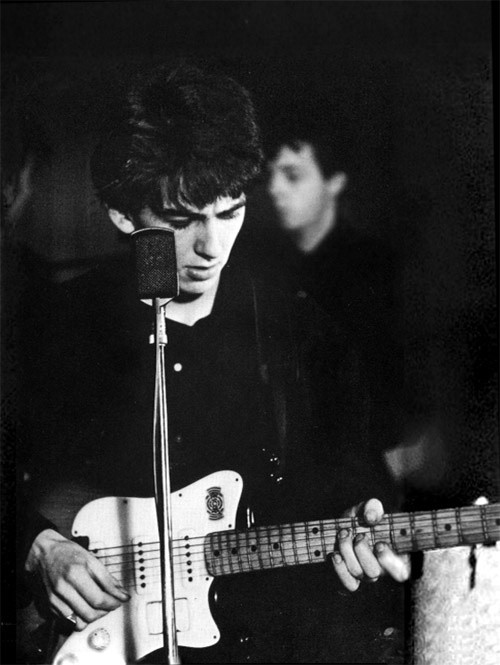 George Harrison's 1958 Resonet Futurama Grazioso guitar
George Harrison's 1958 Resonet Futurama Grazioso guitar
Around 1960, as The Beatles’ popularity grew in Liverpool, Harrison sought a more distinctive electric guitar. He found a 1958 Resonet Futurama Grazioso, a Czech-made guitar with a unique design and sound, at Rushworth and Dreaper’s music shop in Liverpool. This guitar, while quirky and challenging to play (“was a dog to play,” Harrison recalled), offered a distinctive sonic palette with its three pickups and various switching options.
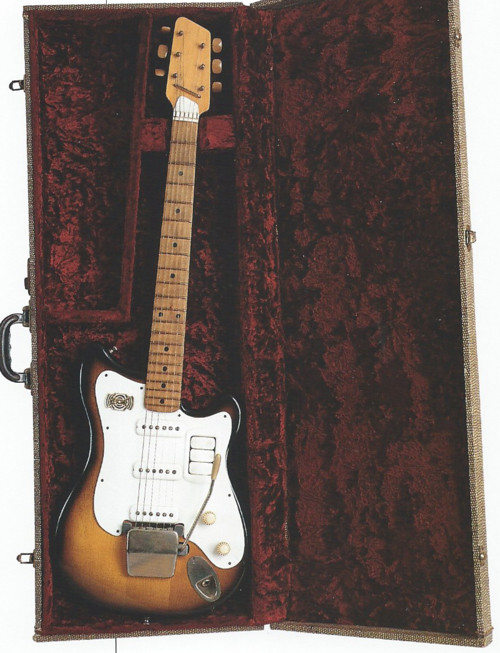 George Harrison's Resonet Futurama in its original case
George Harrison's Resonet Futurama in its original case
The Futurama purchase story is iconic: Paul McCartney, testing the guitar in the shop, accidentally caused an “almighty boom” that knocked other guitars off the wall. Harrison’s mother co-signed the hire-purchase agreement, further demonstrating her support. This Futurama became one of Harrison’s early stage guitars with The Beatles, representing his evolving taste for unique instruments.
1957 Gretsch PX 6128 Duo Jet: His First American Guitar
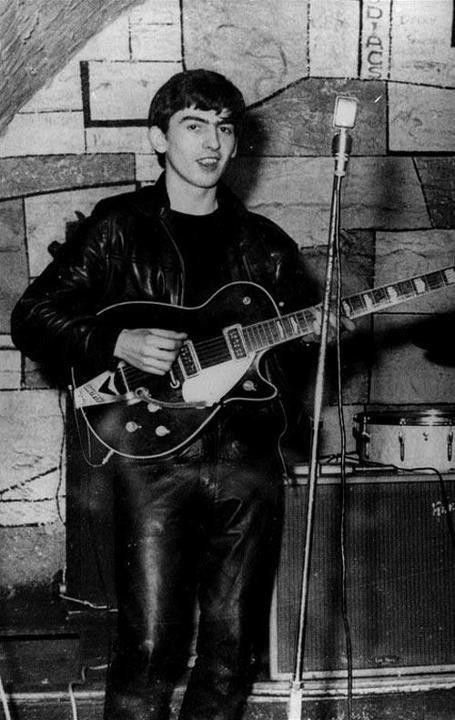 George Harrison with his 1957 Gretsch PX6128 Duo Jet
George Harrison with his 1957 Gretsch PX6128 Duo Jet
In the summer of 1961, George Harrison acquired his first American-made guitar, a 1957 Gretsch PX 6128 Duo Jet. Purchased secondhand from a Liverpool cab driver for £70, this guitar marked a significant upgrade in quality and tone. The Duo Jet, with its solid body, DeArmond pickups, and Bigsby vibrato, became a workhorse instrument for Harrison during The Beatles’ rise to fame.
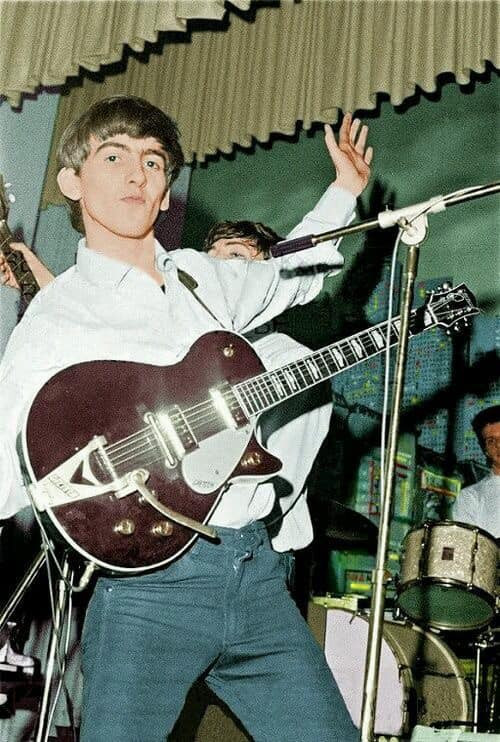 Close-up of George Harrison's 1957 Gretsch Duo Jet
Close-up of George Harrison's 1957 Gretsch Duo Jet
Harrison played the Duo Jet extensively during The Beatles’ formative years, from their Cavern Club days to their breakthrough as a national phenomenon. It was his primary electric guitar during this transformative period. Later, in the mid-1960s, Harrison gifted the Duo Jet to Klaus Voormann, a longtime friend and artist who designed the “Revolver” album cover. However, Harrison eventually reclaimed the guitar, recognizing its “nostalgic value,” and restored it to its original condition. The Gretsch Duo Jet remains a significant instrument in Harrison’s guitar history, representing his move towards professional-grade American guitars.
1957 Gretsch Jet Firebird: A Brief Encounter
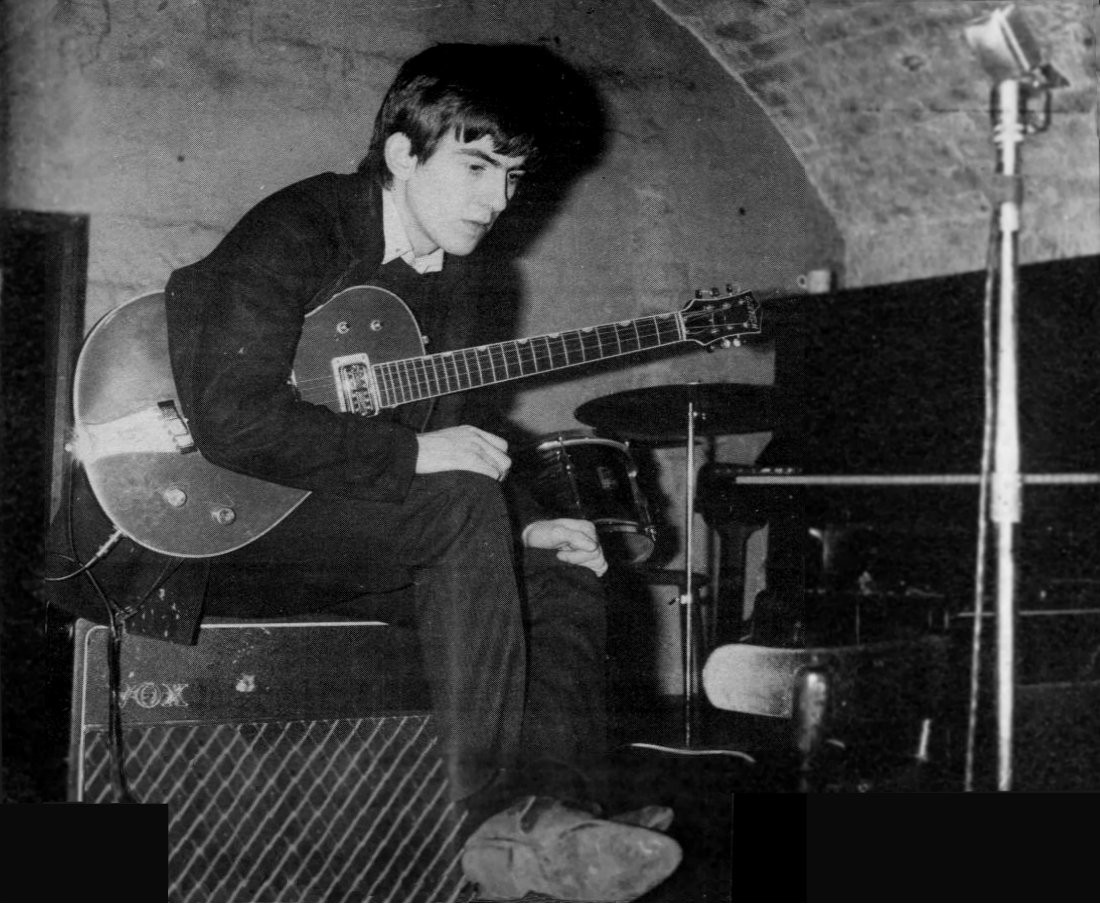 Gretsch Jet Firebird guitar, similar to the one George Harrison borrowed
Gretsch Jet Firebird guitar, similar to the one George Harrison borrowed
While his Duo Jet was being repaired in 1963, George Harrison borrowed a Gretsch Jet Firebird from Rushworth’s. This guitar, initially made for Bo Diddley, was another Gretsch solid-body model. Although Harrison liked the Jet Firebird, he apparently didn’t keep it for long, returning it after the Duo Jet was fixed. This brief period with the Jet Firebird demonstrates Harrison’s continued exploration of Gretsch guitars and his reliance on them during The Beatles’ early success.
The Rickenbacker Era: Defining the Beatles’ Sound
1963 Rickenbacker Fireglo 425: A Gift with a Twist
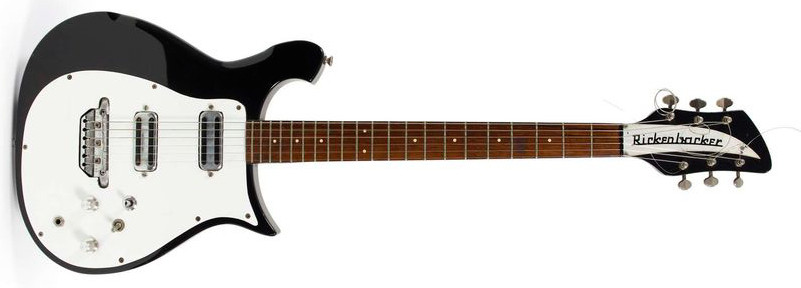 George Harrison's 1963 Rickenbacker Fireglo 425 guitar
George Harrison's 1963 Rickenbacker Fireglo 425 guitar
In 1963, during a visit to his sister in Illinois, George Harrison purchased a Rickenbacker 425 in Fireglo red. Intriguingly, he had the store owner paint it black to match John Lennon’s Rickenbacker. Despite being designated a Model 425, it was actually a vibrato-less Model 420 due to a factory error. This Rickenbacker 425 played a significant role in The Beatles’ early British Invasion era.
 George Harrison playing his black Rickenbacker 425
George Harrison playing his black Rickenbacker 425
Harrison used this black Rickenbacker 425 extensively in late 1963 and early 1964, including prominent TV appearances like “Ready Steady Go!” and “Thank Your Lucky Stars.” He modified the guitar by adding a second pickup, resembling a Rickenbacker 450 model. Later, Harrison gifted this 425 to George Peckham of The Fourmost, who eventually auctioned it. This guitar’s journey from Harrison’s hands to auction and finally to the Rock and Roll Hall of Fame underscores its historical importance in Beatles history.
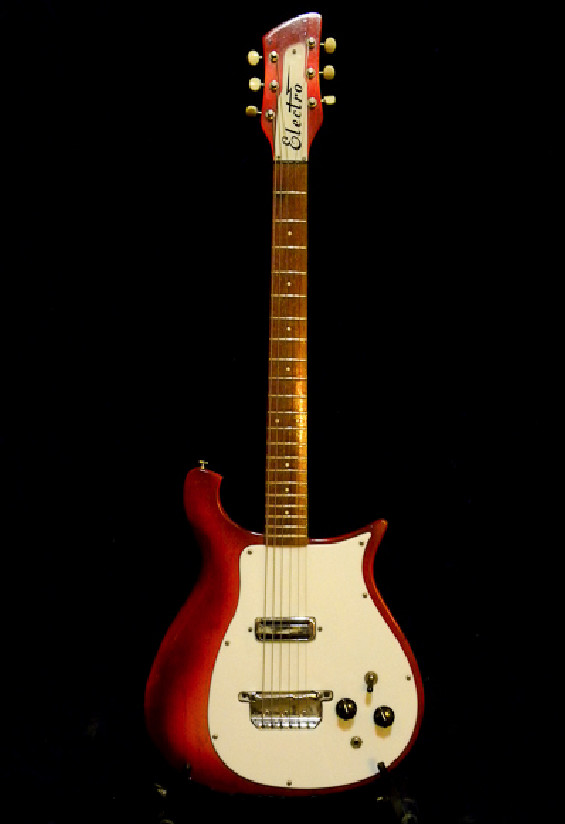 Close-up of the original Fireglo red color under the black paint on the Rickenbacker 425
Close-up of the original Fireglo red color under the black paint on the Rickenbacker 425
1963 Maton MS-500 Mastersound: A Temporary Loan
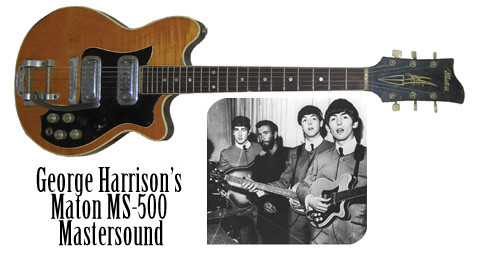 Maton MS-500 Mastersound guitar, similar to the one George Harrison borrowed
Maton MS-500 Mastersound guitar, similar to the one George Harrison borrowed
In 1963, while his first Gretsch Country Gentleman was under repair, George Harrison borrowed a Maton MS-500 Mastersound. This Australian-made guitar was used in photos from performances in June and July 1963. However, Harrison never owned this Maton; it was eventually acquired by Roy Barber of Dave Berry’s backing band, The Cruisers. The Maton MS-500 remains a lesser-known but interesting chapter in Harrison’s guitar story, representing a brief period when he explored instruments beyond American and British brands.
1962 Gretsch 6122 Country Gentleman (First and Second): A Trademark Sound
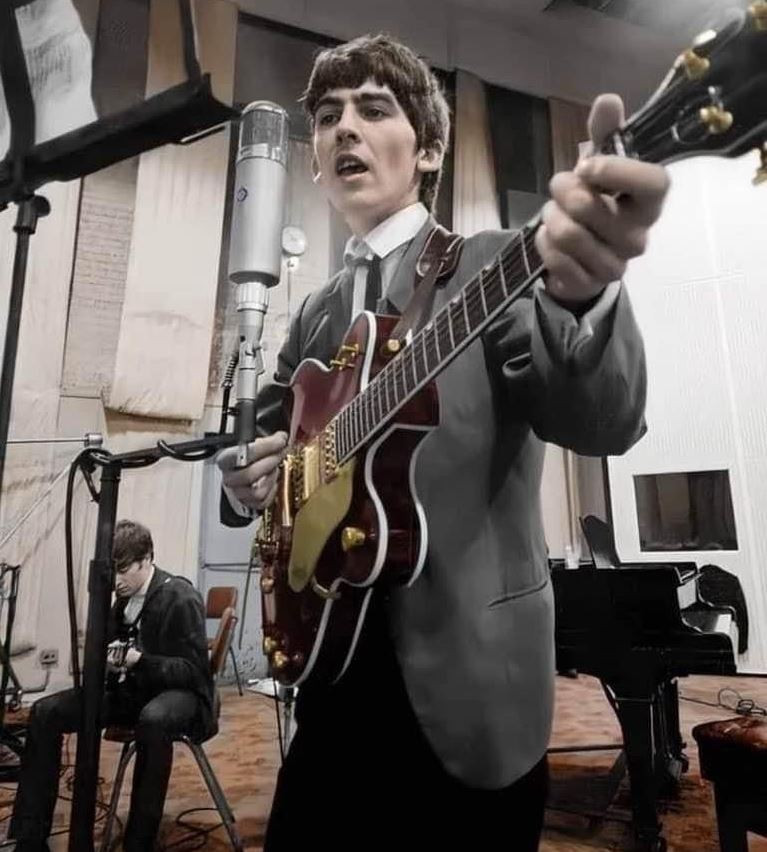 George Harrison's first 1962 Gretsch 6122 Country Gentleman guitar
George Harrison's first 1962 Gretsch 6122 Country Gentleman guitar
George Harrison became strongly associated with the Gretsch Country Gentleman, owning two of these iconic guitars. His first, a 1962 model purchased in 1963, featured “screw-down” mutes. This guitar, however, met an unfortunate end when it was smashed during a Beatles tour in 1965.
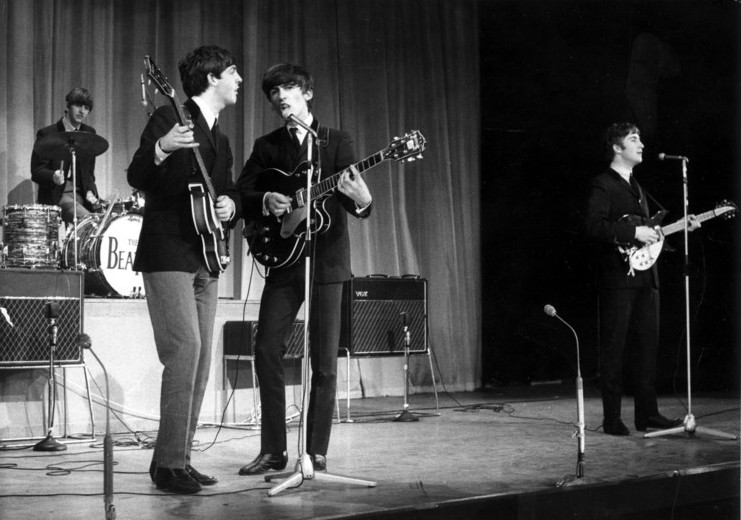 George Harrison playing his first Country Gentleman at a rehearsal in 1963
George Harrison playing his first Country Gentleman at a rehearsal in 1963
His second Country Gentleman, also a 1962 model but with “flip-up” mutes, became his favored instrument. Sound City in London provided this guitar while the first was being repaired, and Harrison preferred the flip-up mutes. This second Country Gentleman is prominently featured in the Sullivan shows and the 1964 US tour, becoming a visual and sonic symbol of The Beatles’ global breakthrough.
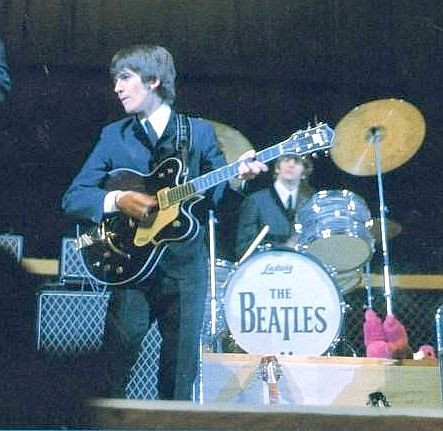 George Harrison with his second 1963 Gretsch 6122 Country Gentleman guitar
George Harrison with his second 1963 Gretsch 6122 Country Gentleman guitar
The Country Gentleman sound became synonymous with Harrison’s playing in the mid-1960s, contributing to classic Beatles tracks. Interestingly, this second Country Gentleman was later given away by Harrison to Brian O’Hara of The Fourmost, further illustrating the interconnectedness of the Liverpool music scene.
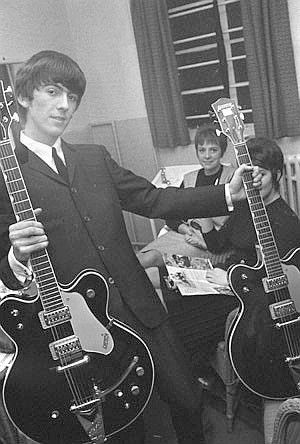 Both of George Harrison's Gretsch Country Gentleman guitars photographed together in 1963
Both of George Harrison's Gretsch Country Gentleman guitars photographed together in 1963
1962 Gretsch “Chet Atkins” Tennessean: Shea Stadium and Beyond
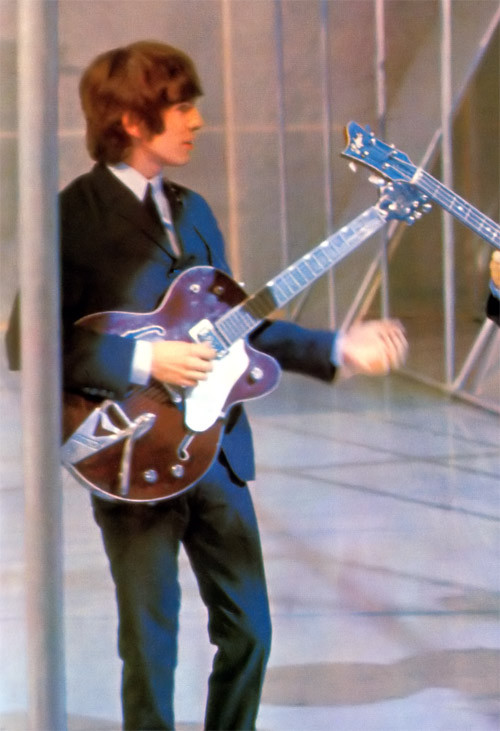 George Harrison's 1962 Gretsch "Chet Atkins" Tennessean guitar
George Harrison's 1962 Gretsch "Chet Atkins" Tennessean guitar
Another significant Gretsch in Harrison’s collection was his 1962 “Chet Atkins” Tennessean. This guitar is particularly notable for being the exclusive guitar Harrison played at the historic Shea Stadium concert in 1965. The Tennessean, a thinline hollow-body, offered a slightly different tone compared to the Country Gentleman, and Harrison utilized it extensively in live performances and recordings.
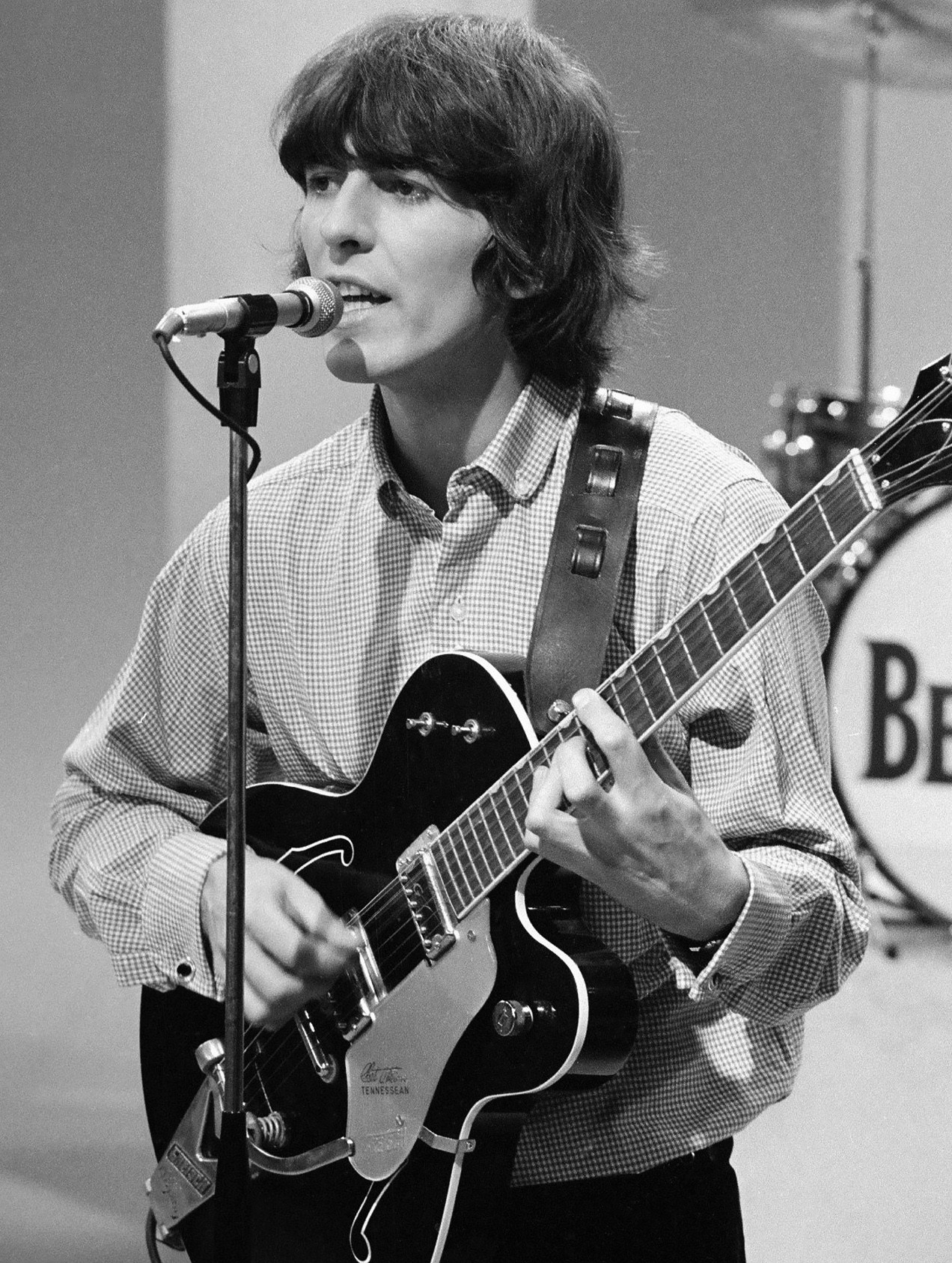 George Harrison playing his Gretsch Tennessean guitar
George Harrison playing his Gretsch Tennessean guitar
This guitar was later auctioned off by Ringo Starr in 2015, highlighting its provenance and connection to Beatles history. Despite some debate about its exact specifications, the 1962 Gretsch Tennessean remains a crucial part of George Harrison’s guitar legacy, particularly for its association with the groundbreaking Shea Stadium performance.
Acoustic Interludes: Gibson J-160E and Ramírez Classical
1962 Gibson J-160E: The Acoustic Workhorse
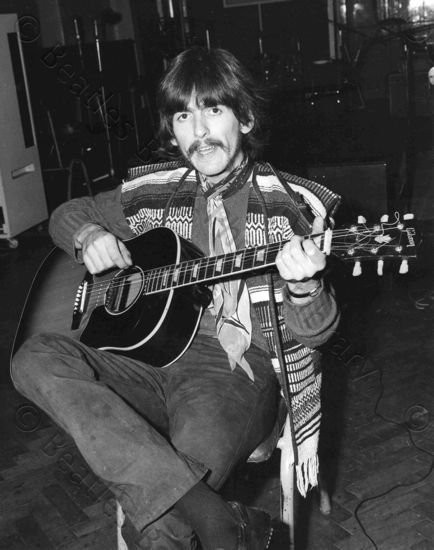 George Harrison's 1962 Gibson J-160E acoustic-electric guitar
George Harrison's 1962 Gibson J-160E acoustic-electric guitar
In 1962, George Harrison and John Lennon famously acquired matching Gibson J-160E acoustic-electric guitars. Ordered from Rushworth’s in Liverpool, these guitars became essential tools for The Beatles’ songwriting and recording. Harrison’s J-160E, though technically purchased on John Lennon’s account initially, became a constant companion in the studio.
George Harrison playing his Gibson J-160E guitar, demonstrating its use in both acoustic and electric contexts.
Interestingly, Harrison’s J-160E was stolen at a Christmas show in 1963, although initially, John Lennon believed his guitar was stolen. This mix-up highlights the close similarity between the two guitars. However, Harrison acquired a replacement in 1964, continuing to rely on the J-160E.
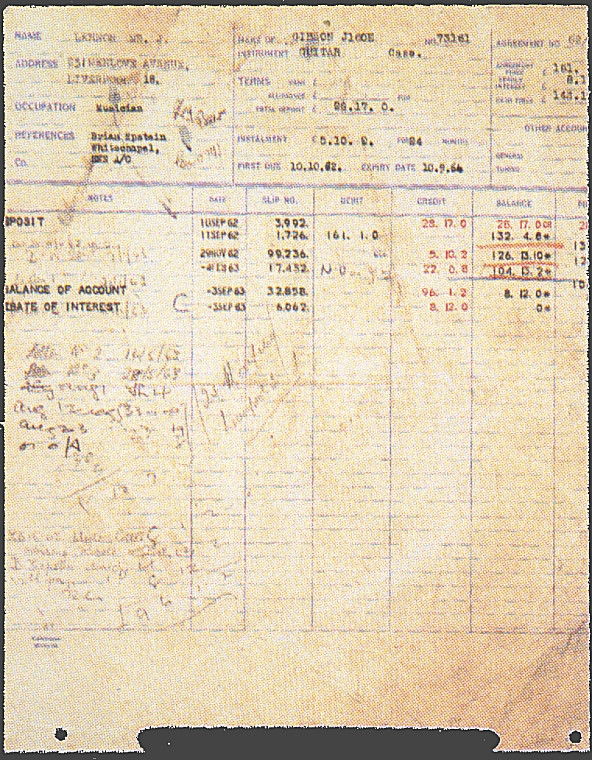 The purchase receipt for George Harrison's Gibson J-160E guitar
The purchase receipt for George Harrison's Gibson J-160E guitar
The Gibson J-160E holds a unique distinction: it is reportedly the only Beatles guitar played on every single Beatles album. Its versatility as both an acoustic and electric instrument made it invaluable in the studio, contributing to countless Beatles classics. Adding to the intrigue, John Lennon’s original stolen 1962 J-160E resurfaced after 50 years, further cementing the historical significance of these guitars.
1964 José Ramírez Guitarra de Estudio: Classical Tones
 George Harrison's 1964 José Ramírez Guitarra de Estudio classical guitar
George Harrison's 1964 José Ramírez Guitarra de Estudio classical guitar
For a different sonic texture, George Harrison utilized a 1964 José Ramírez Guitarra de Estudio classical guitar. This Spanish-made instrument added a nylon-string warmth to Beatles tracks like “Til There Was You” and “And I Love Her,” both featured in the film “A Hard Day’s Night.”
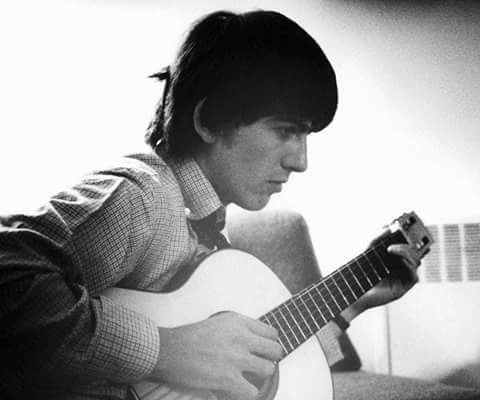 George Harrison playing his José Ramírez classical guitar
George Harrison playing his José Ramírez classical guitar
The Ramírez classical guitar showcased Harrison’s versatility and willingness to explore different musical styles within The Beatles’ repertoire. It’s a testament to his musicality that he could seamlessly transition between rock and roll electric guitars and the delicate nuances of a classical guitar.
The Twelve-String Sound: Rickenbacker 360/12 and Gretsch 12-String
1963 Rickenbacker 360/12 (First and Second): A Signature Jangle
 George Harrison's first 1963 Rickenbacker 360/12 twelve-string guitar
George Harrison's first 1963 Rickenbacker 360/12 twelve-string guitar
George Harrison’s most iconic guitar, arguably, is his Rickenbacker 360/12 twelve-string. His first 360/12, acquired in 1963, was the second twelve-string guitar Rickenbacker ever made. This Fireglo red guitar, with its distinctive jangling sound, became a signature element of The Beatles’ mid-60s sound.
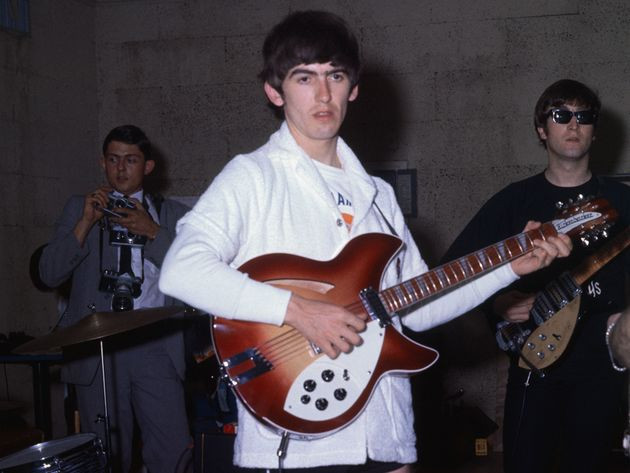 Close-up of the headstock and unique stringing of George Harrison's Rickenbacker 360/12
Close-up of the headstock and unique stringing of George Harrison's Rickenbacker 360/12
Harrison’s 360/12 was unique in its stringing configuration, reversing the octave strings for the lower four courses, which became the standard for all subsequent Rickenbacker twelve-strings. This guitar was instrumental in hits like “A Hard Day’s Night” and “Ticket to Ride,” forever linking the Rickenbacker 360/12 to The Beatles’ sound.
 George Harrison playing his first Rickenbacker 360/12 guitar
George Harrison playing his first Rickenbacker 360/12 guitar
In 1965, Harrison received a second Rickenbacker 360/12 during The Beatles’ US tour. This new model, with rounded cutaways and different binding, became his primary stage twelve-string, while his first 360/12 was “retired” from stage use. Sadly, this second Rickenbacker 360/12 was stolen in 1966, adding a layer of mystery to its fate. The Rickenbacker 360/12, in both its iterations, remains deeply intertwined with George Harrison’s musical identity and The Beatles’ enduring legacy.
1964 Gretsch “George Harrison Model” 12-String: A Disliked Gift
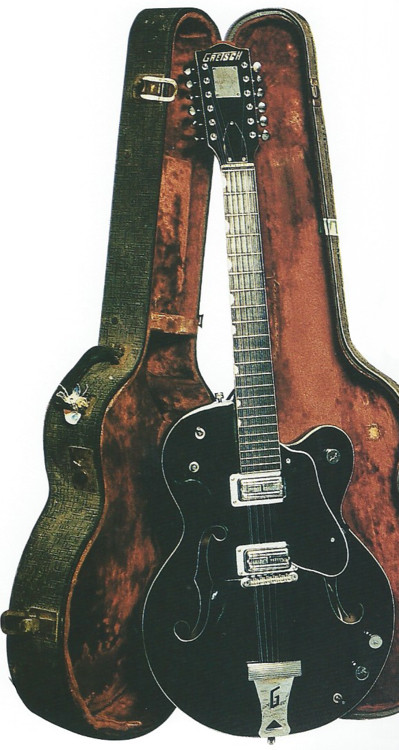 Gretsch "George Harrison Model" 12-string guitar
Gretsch "George Harrison Model" 12-string guitar
In 1964, Gretsch gifted George Harrison a custom “George Harrison Model” 12-string guitar, a 12-string version of his 6128 Duo Jet. However, Harrison reportedly disliked this guitar, finding the neck too wide and the action poor. He ultimately gave it to John St John of Sounds Incorporated. This Gretsch 12-string, while a unique and personalized gift, did not resonate with Harrison like his Rickenbacker 360/12, highlighting the importance of playability and personal preference in guitar selection.
Gibson Solid Bodies: ES-345, SG Standard, and Les Paul “Lucy”
1965 Gibson ES-345-TD: A Short but Notable Appearance
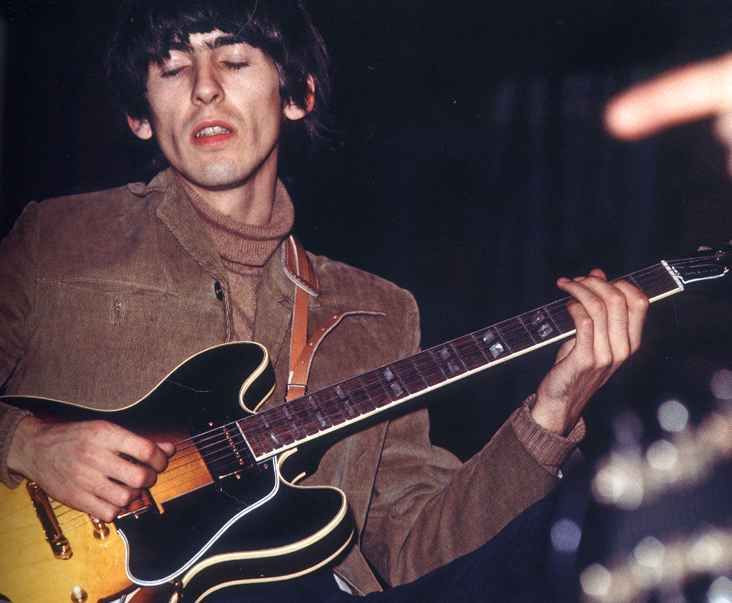 George Harrison's 1965 Gibson ES-345-TD guitar
George Harrison's 1965 Gibson ES-345-TD guitar
George Harrison briefly used a 1965 Gibson ES-345-TD, a semi-hollowbody guitar, primarily for promo films and UK tours in 1965. Seen in promos for “We Can Work It Out” and “Day Tripper,” the ES-345 offered a different Gibson tone compared to his solid-body guitars. While not as extensively used as some of his other instruments, the ES-345 represents Harrison’s exploration of Gibson’s semi-hollow models during The Beatles’ peak.
1964 Gibson SG Standard: Revolver and Beyond
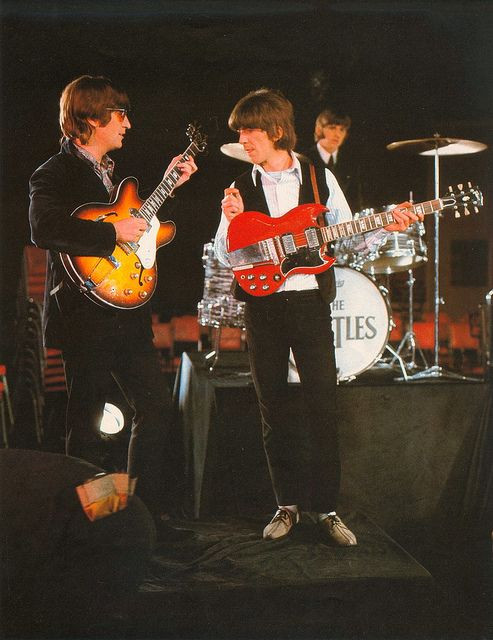 George Harrison with his 1964 Gibson SG Standard guitar
George Harrison with his 1964 Gibson SG Standard guitar
In 1966, George Harrison acquired a 1964 Gibson SG Standard, which became a mainstay during the “Revolver” sessions and remained a favorite through 1968. The SG, with its lightweight body and powerful humbucker pickups, offered a raw, biting tone that suited the evolving psychedelic sound of The Beatles.
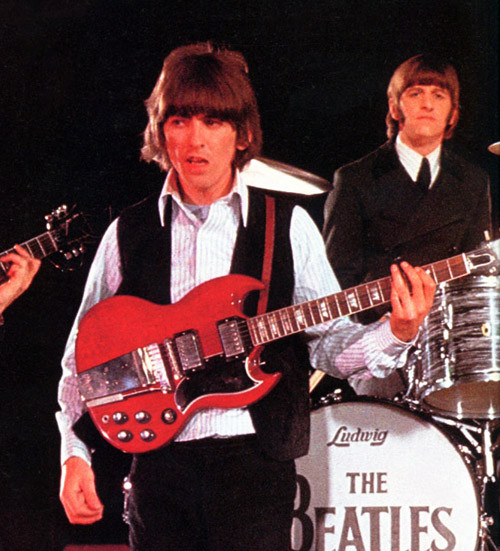 Close-up of George Harrison's Gibson SG Standard guitar
Close-up of George Harrison's Gibson SG Standard guitar
Harrison used the SG extensively on “Revolver” tracks and live performances. He later gifted this SG to Pete Ham of Badfinger, connecting it to another significant artist in the Apple Records family. In 2004, Harrison’s Gibson SG was sold at auction for a substantial sum, reflecting its iconic status and Beatles provenance.
1957 Gibson Les Paul “Lucy”: A Gift from Clapton, Stolen and Recovered
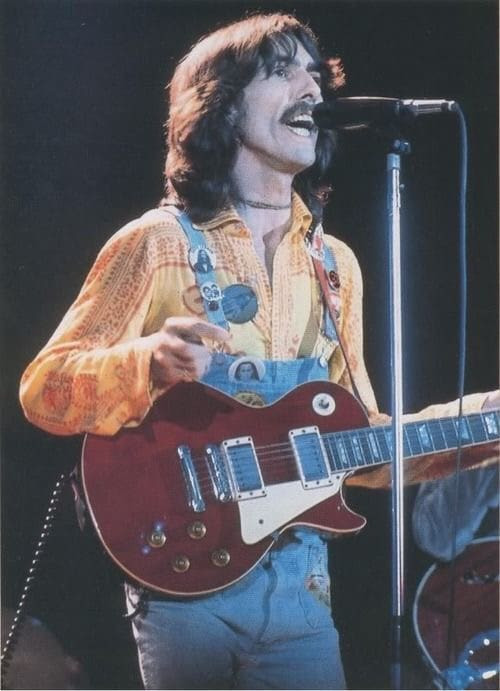 George Harrison's 1957 Gibson Les Paul "Lucy" guitar
George Harrison's 1957 Gibson Les Paul "Lucy" guitar
Perhaps the most famous Gibson in George Harrison’s collection is “Lucy,” a 1957 Les Paul originally gifted to him by Eric Clapton in 1968. This guitar, previously owned by John Sebastian and Rick Derringer, had been refinished in a striking SG-style red. Clapton gave “Lucy” to Harrison around the time of the “White Album” sessions.
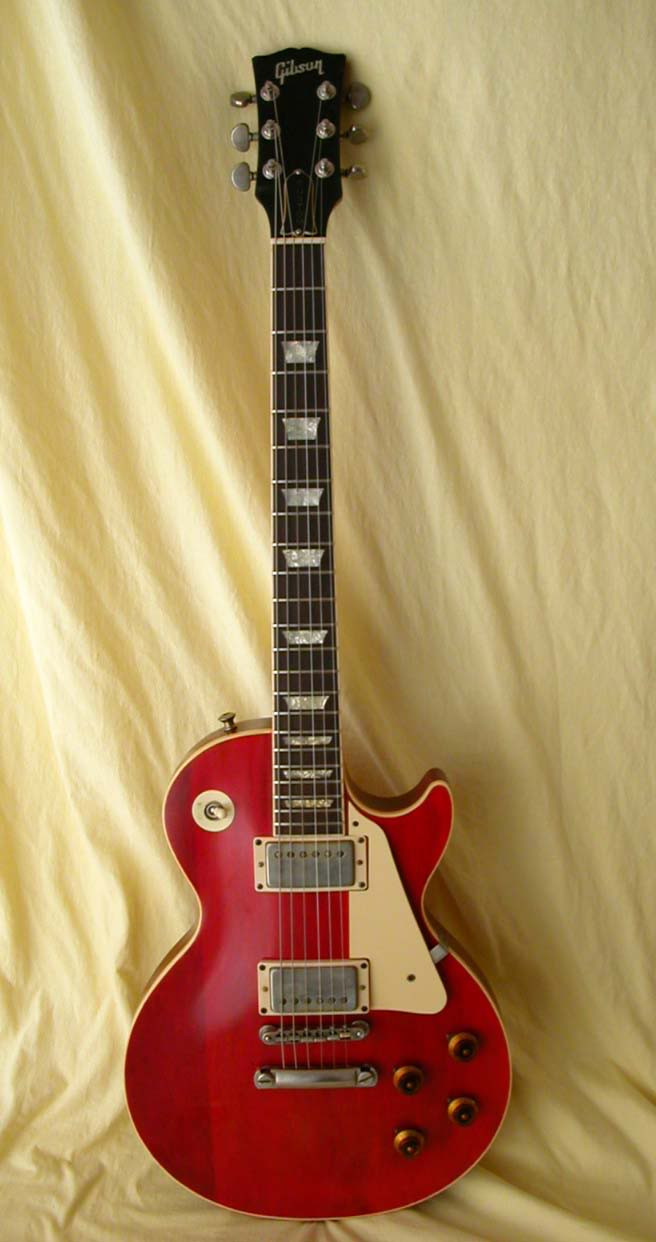 George Harrison playing "Lucy" the Les Paul guitar
George Harrison playing "Lucy" the Les Paul guitar
“Lucy” is most famously associated with Eric Clapton’s iconic guitar solo on “While My Guitar Gently Weeps.” Harrison, wanting a lead guitar part for the song, invited Clapton to play, knowing his bandmates would be on their best behavior with a guest present. Clapton played the solo in one take on “Lucy,” creating a legendary moment in rock history.
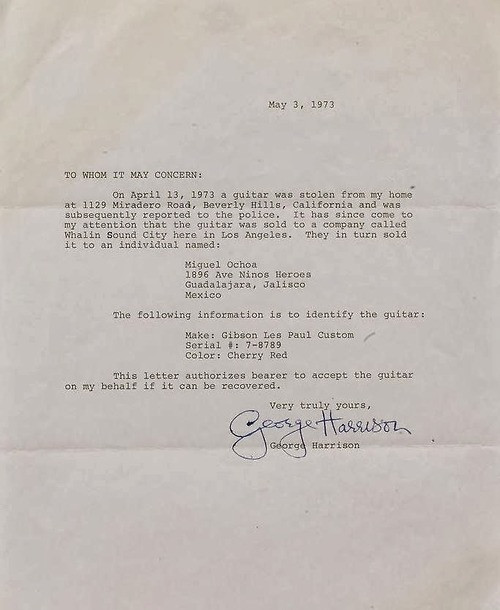 Letter confirming the theft and recovery of George Harrison's "Lucy" Les Paul guitar
Letter confirming the theft and recovery of George Harrison's "Lucy" Les Paul guitar
“Lucy” also had a dramatic chapter in its history: it was stolen from Harrison’s home in 1973 but eventually recovered after a unique “kidnapping” scenario involving a trade for another guitar. “Lucy” remained one of Harrison’s prized guitars until his death and is still owned by his estate today, a testament to its enduring legacy.
Fender Explorations: Stratocasters, Telecasters, and Bass VIs
1961 Fender Stratocaster “Rocky”: Psychedelic and Iconic
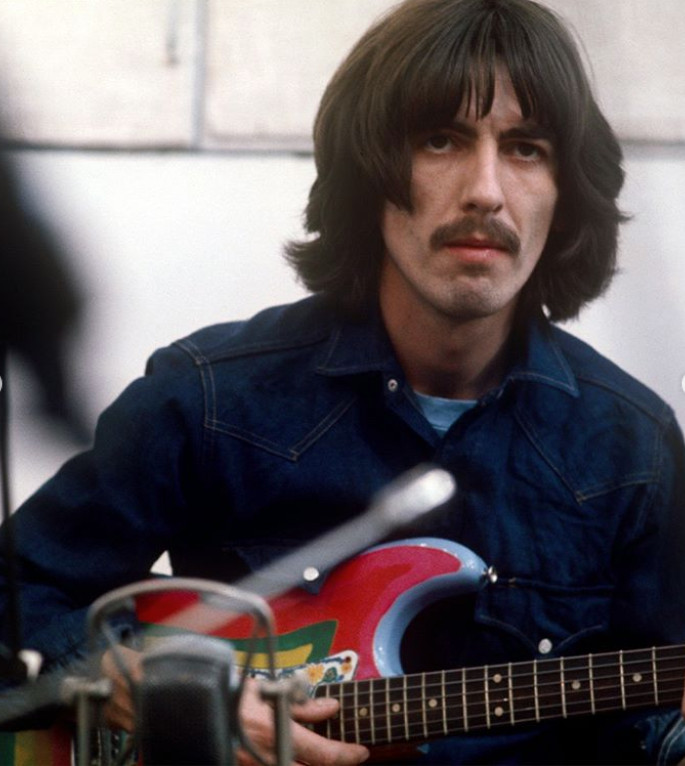 George Harrison's 1961 Fender Stratocaster "Rocky" guitar
George Harrison's 1961 Fender Stratocaster "Rocky" guitar
George Harrison’s “Rocky” Stratocaster is another visually and sonically iconic instrument. Originally a Sonic Blue Fender Stratocaster, Harrison painted it in psychedelic colors in 1967, naming it “Rocky.” This Stratocaster became associated with the psychedelic era of The Beatles, famously used in the “All You Need Is Love” and “Magical Mystery Tour” period.
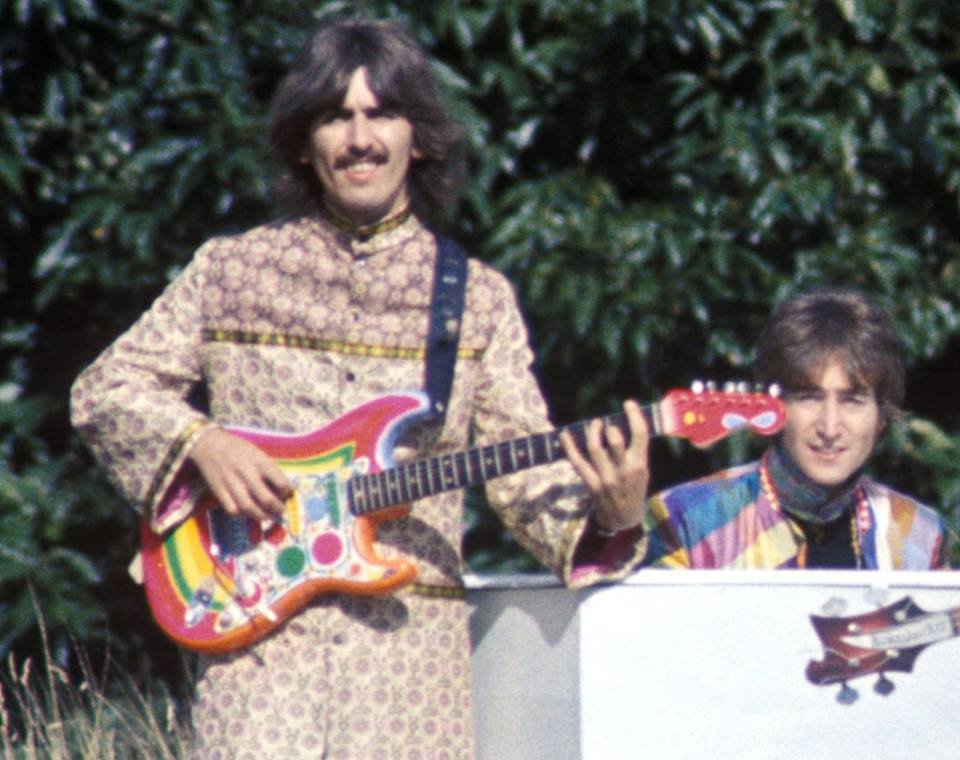 George Harrison playing "Rocky" the Stratocaster on Magical Mystery Tour
George Harrison playing "Rocky" the Stratocaster on Magical Mystery Tour
“Rocky” was played on tracks like “You’re Gonna Lose That Girl” and “Nowhere Man” before its psychedelic transformation. Harrison’s decision to paint “Rocky” reflects the era’s artistic experimentation and his personal expression through his instruments. “Rocky” remains one of the most recognizable and celebrated guitars in Harrison’s collection.
1969 Fender Rosewood Telecaster: A Rooftop Gift
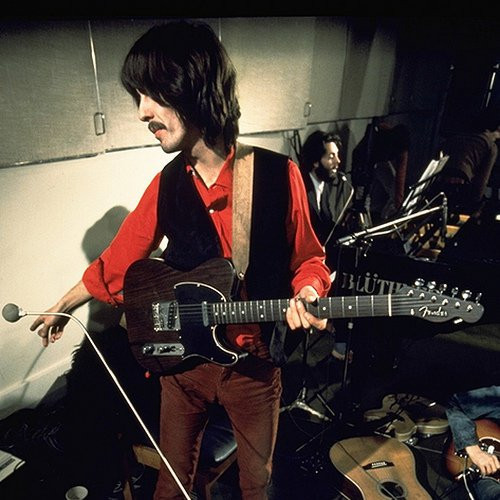 George Harrison's 1969 Fender Rosewood Telecaster guitar
George Harrison's 1969 Fender Rosewood Telecaster guitar
In 1969, Fender gifted George Harrison a unique Rosewood Telecaster, one of only two made at the time. This Telecaster, crafted entirely of rosewood with a maple middle layer, was presented to Harrison and Ringo Starr. Harrison played this Telecaster during the “Let It Be” sessions and the iconic rooftop concert in 1969.
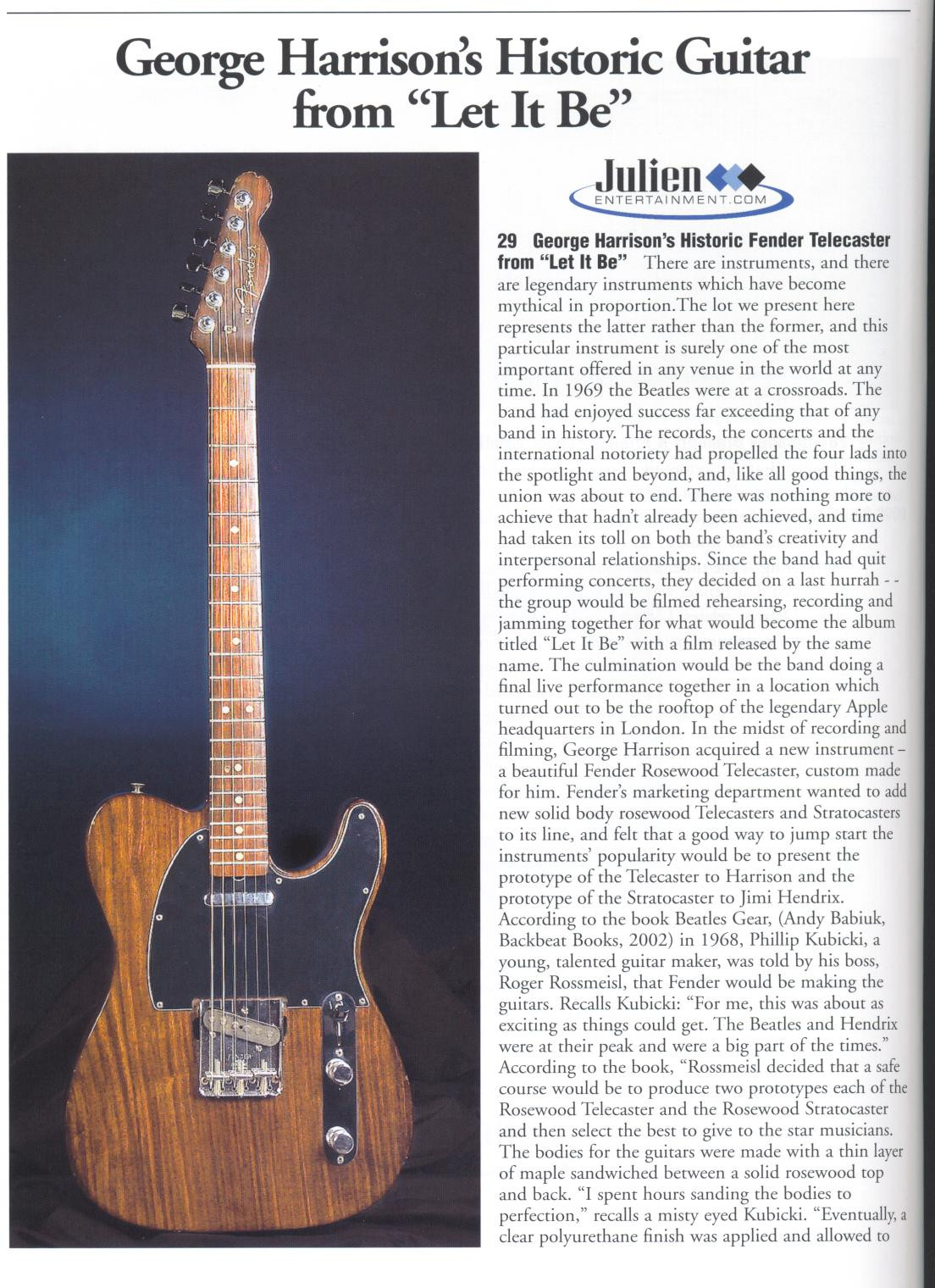 George Harrison playing the Rosewood Telecaster on the rooftop concert
George Harrison playing the Rosewood Telecaster on the rooftop concert
Shortly after receiving it, Harrison gifted the Rosewood Telecaster to Delaney Bramlett of Delaney and Bonnie, solidifying its legendary status. This Telecaster, with its unique construction and Beatles provenance, is a highly sought-after and historically significant instrument.
Fender VI 6-String Bass: Versatility and Unique Tones
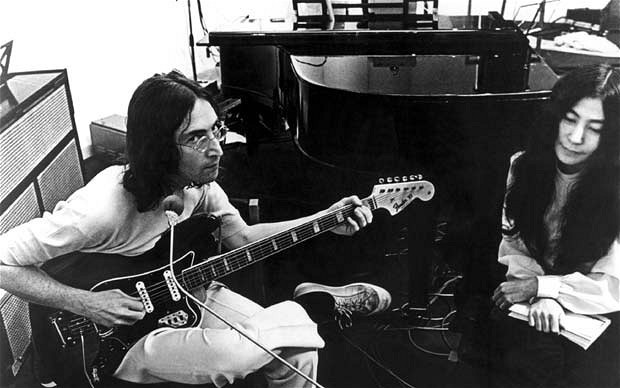 John Lennon playing a Fender VI 6-string bass guitar
John Lennon playing a Fender VI 6-string bass guitar
While primarily associated with bass, the Fender VI 6-string bass guitar found its way into George Harrison’s hands. Originally released in 1961, the Fender VI is tuned an octave below a standard guitar. John Lennon played the Fender VI on “Helter Skelter,” and George Harrison used it in the “Hey Jude” promo video, showcasing its versatility and unique tonal range. The Fender VI added a distinctive low-end texture to certain Beatles recordings and performances.
1965-1970 Fender Electric XII: A Twelve-String Alternative
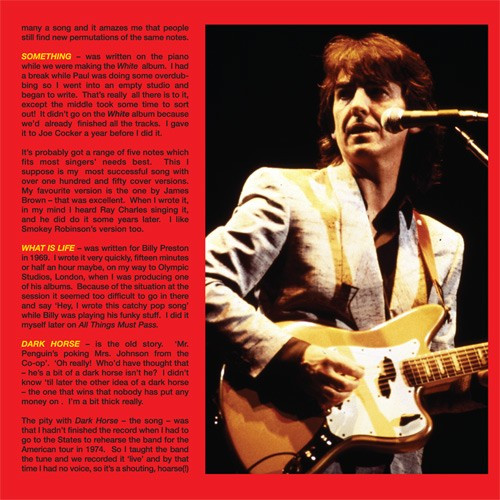 George Harrison playing a Fender Electric XII twelve-string guitar in Japan in 1991
George Harrison playing a Fender Electric XII twelve-string guitar in Japan in 1991
Later in his career, George Harrison also utilized a Fender Electric XII twelve-string guitar. This model, introduced in the mid-1960s, offered a different twelve-string voice compared to his Rickenbacker 360/12. While the Electric XII was not as prominently featured in Beatles recordings, Harrison used it in later performances, demonstrating his continued interest in exploring twelve-string sounds.
Acoustic Gems: Gibson J-200 Jumbo, Zemaitis, and Harptone
1969 Gibson J-200 Jumbo Acoustic: A Powerful Sound
George Harrison with his 1969 Gibson J-200 Jumbo acoustic guitar, a powerful instrument used on “The White Album” and “All Things Must Pass.”
George Harrison upgraded his acoustic arsenal with a 1969 Gibson J-200 Jumbo acoustic guitar. This large-bodied guitar, known for its powerful and resonant sound, became a favorite for Harrison in the late Beatles era and his solo career. Lennon also used Harrison’s J-200 on “Two of Us” and other acoustic tracks on “Let It Be.”
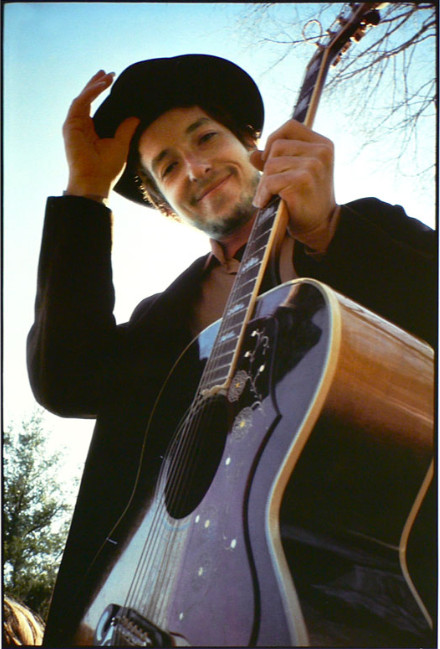 Bob Dylan with a Gibson J-200 guitar, possibly the same one owned by George Harrison
Bob Dylan with a Gibson J-200 guitar, possibly the same one owned by George Harrison
Harrison used the J-200 extensively on “The White Album,” including tracks like “While My Guitar Gently Weeps,” “Here Comes the Sun,” and “Long, Long, Long.” He also composed most of his solo debut album, “All Things Must Pass,” on a blonde Gibson J-200. There’s even speculation that Harrison’s J-200 is the same guitar Bob Dylan is seen holding on the cover of his “Nashville Skyline” album, further adding to its mystique.
Zemaitis Acoustics: Exquisite Craftsmanship
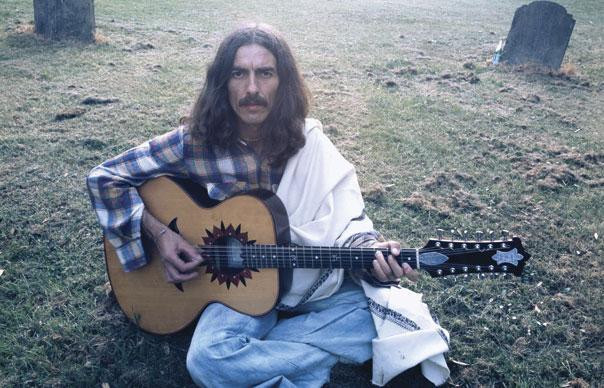 George Harrison with his Zemaitis "Lotus" 12-string acoustic guitar
George Harrison with his Zemaitis "Lotus" 12-string acoustic guitar
In later years, George Harrison became a fan of Zemaitis guitars, known for their elaborate ornamentation and exceptional craftsmanship. He owned both a Zemaitis 12-string acoustic, nicknamed “Lotus,” and a 6-string Zemaitis acoustic. These guitars, built by Tony Zemaitis, represented Harrison’s appreciation for high-quality, unique instruments beyond mainstream brands. The Zemaitis acoustics are visually stunning and sonically rich, reflecting Harrison’s refined taste in guitars.
Harptone L/12NC: Concert for Bangladesh Acoustic
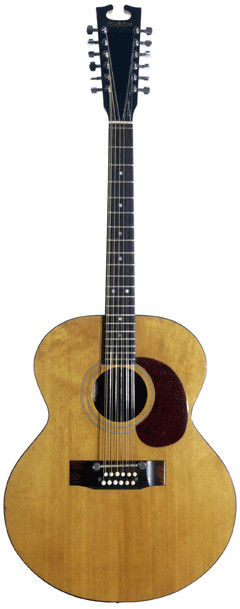 George Harrison's Harptone L/12NC 12-string acoustic guitar
George Harrison's Harptone L/12NC 12-string acoustic guitar
George Harrison also owned a Harptone L/12NC 12-string acoustic guitar. While there’s no definitive proof it was used on Beatles recordings, Harrison and members of Badfinger used it during sessions for “All Things Must Pass.” Most famously, Badfinger’s Tom Evans played this Harptone at the Concert for Bangladesh charity shows in 1971. This Harptone, later gifted to Bob Purvis of Splinter, is another example of Harrison’s diverse acoustic guitar collection and its connection to significant musical events.
Beyond Guitars: Sitars and Bartell Fretless
Sitars: Exploring Indian Sounds
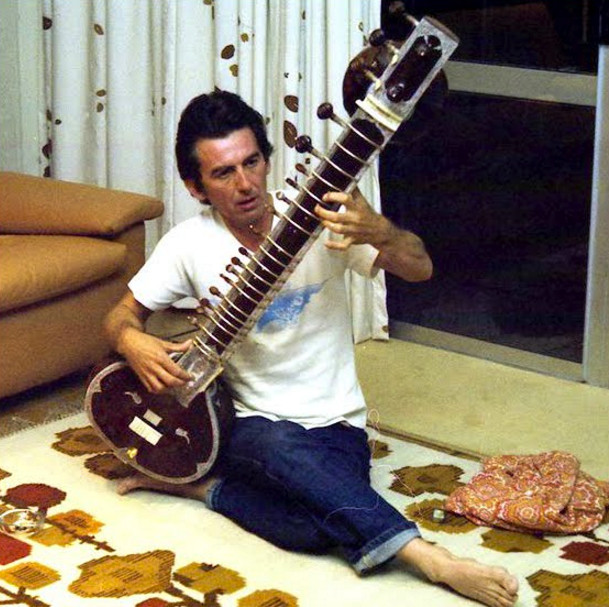 George Harrison with a sitar, an instrument he popularized in Western music
George Harrison with a sitar, an instrument he popularized in Western music
George Harrison’s interest in Indian music and culture is well-documented, and the sitar became a significant instrument in his musical journey. His first sitar, purchased in 1965, was famously used on The Beatles’ “Norwegian Wood,” marking the first time a sitar was used in a Western rock recording.
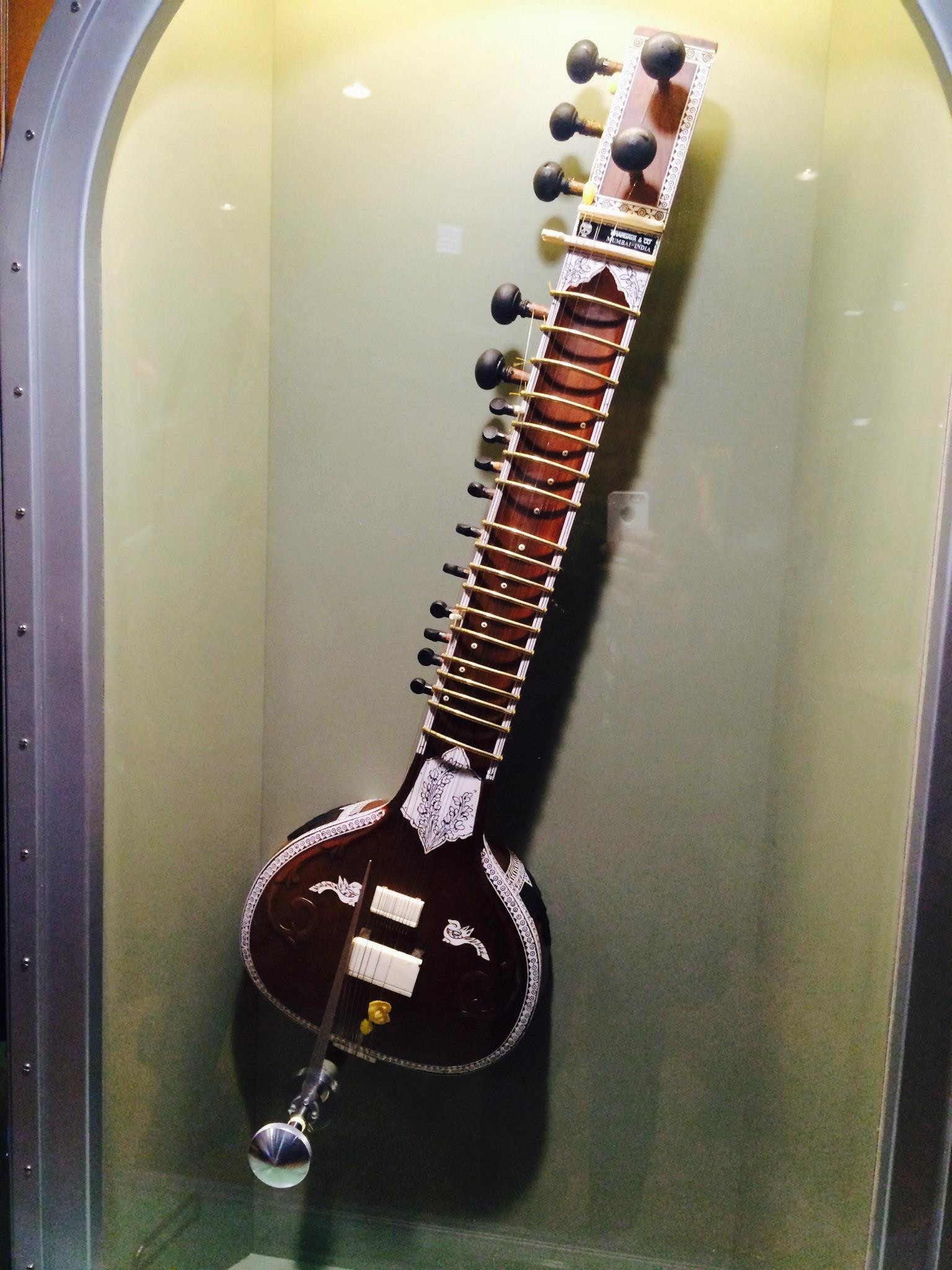 George Harrison's sitar on display at a Beatles exhibit
George Harrison's sitar on display at a Beatles exhibit
Harrison later studied sitar with Ravi Shankar, deepening his understanding and appreciation for Indian classical music. He owned multiple sitars, including a Ravi Shankar-type sitar purchased in India in 1966 from Rikhi Ram Musical Instruments. Harrison’s embrace of the sitar broadened The Beatles’ sonic palette and introduced Indian sounds to a global audience.
1960s Bartell Fretless Guitar: An Unusual Prototype
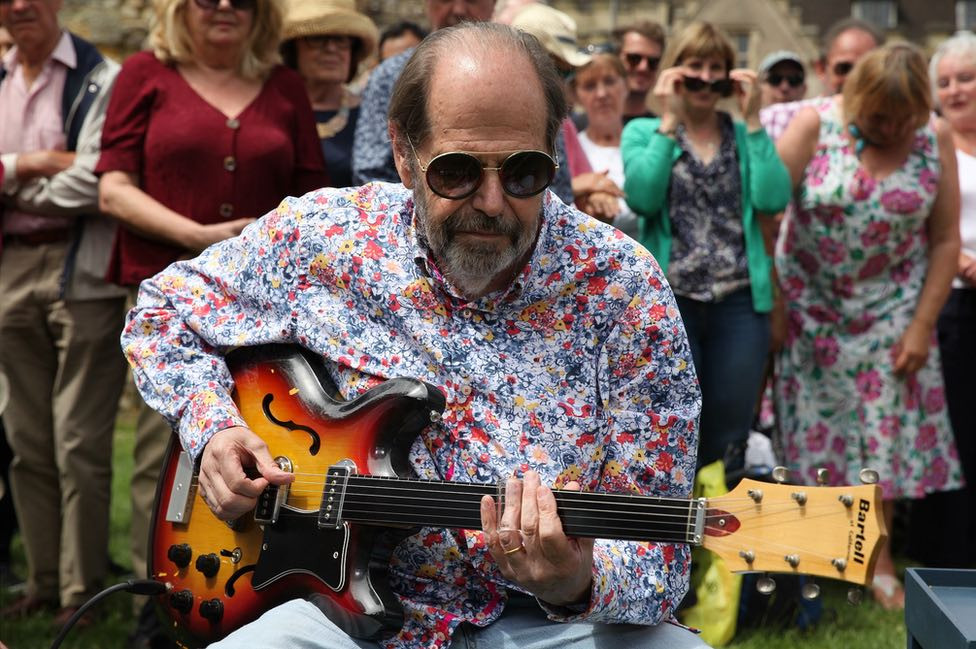 Bartell Fretless guitar, similar to the prototype owned by George Harrison
Bartell Fretless guitar, similar to the prototype owned by George Harrison
An intriguing and rare instrument in Harrison’s collection was a 1960s Bartell Fretless guitar. This ultra-rare prototype, initially intended for John Lennon, was eventually given to Harrison. Bartell guitars, made in California in limited numbers, were known for their unique designs. This fretless guitar, featured on the BBC’s “Antiques Roadshow,” is a testament to Harrison’s interest in unusual and experimental instruments.
A Lasting Legacy: George Harrison’s Guitar Influence
George Harrison’s guitar collection is more than just a list of instruments; it’s a reflection of his musical journey, his evolving tastes, and his profound influence on popular music. From his humble beginnings with a Rosetti acoustic to his iconic Rickenbackers, Gretsches, Gibsons, and Fenders, Harrison’s guitar choices shaped the sound of The Beatles and his solo work. His willingness to explore different brands, models, and even instruments like the sitar, demonstrates his restless musical curiosity and his commitment to sonic innovation.
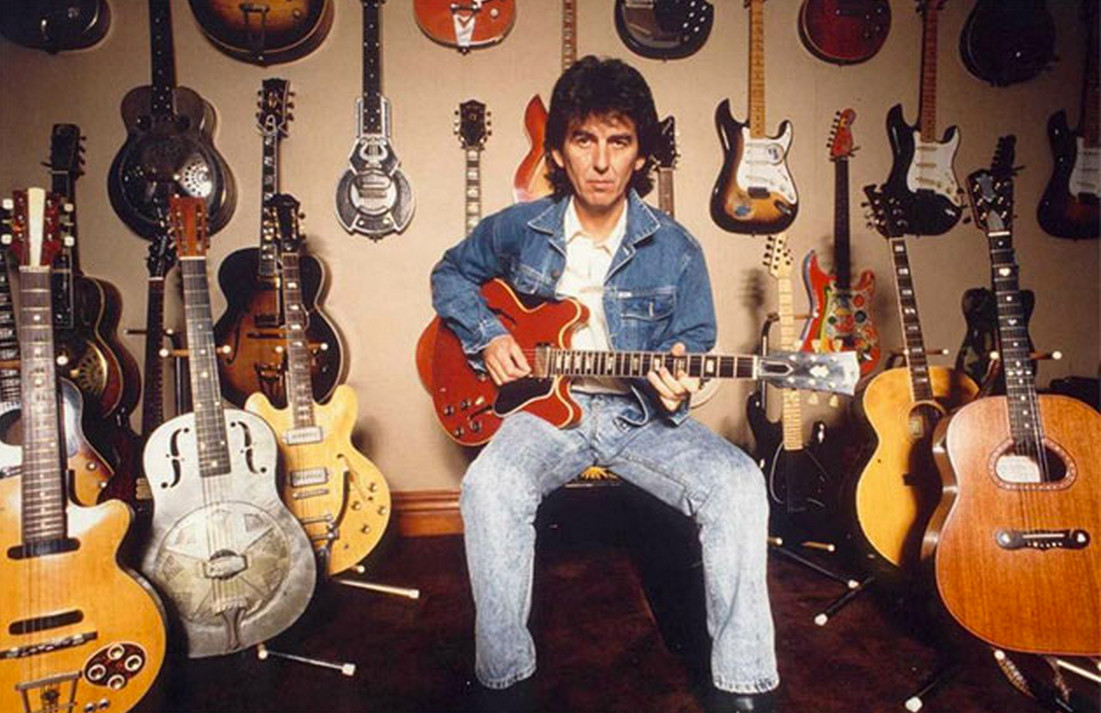 George Harrison's guitar collection displayed in photos
George Harrison's guitar collection displayed in photos
George Harrison’s impact as a guitarist is undeniable. He wasn’t just a “quiet Beatle”; he was a thoughtful and innovative musician whose guitar work was essential to the magic of The Beatles. His collection of guitars serves as a tangible reminder of his musical genius and his enduring legacy as one of rock’s most influential guitarists.
Which George Harrison guitar is your favorite? Let us know in the comments below!
